Over the past few months, I’ve deeply analyzed how Google’s AI Overviews handle long-tail queries, dug into what makes brands visible in large language models (LLMs), and worked with brands trying to future-proof their SEO strategies.
Today’s Memo is the first in a two-part series where I’m covering a tactical deep dive into one of the most overlooked mindset shifts in SEO: optimizing for topics (not just keywords).
In this issue, I’m breaking down:
- Why keyword-first SEO creates surface-level content and cannibalization.
- What the actual differences are. (Isn’t this just a pillar-cluster approach? Nope.)
- Thoughts from other pros across the web.
- How to talk through these issues with your stakeholders, i.e., clients, the C-suite, and your teams (for premium subscribers).
And next week, I’ll cover how to build a topic map, and operationalize a topic-first approach to SEO across your team.
If you’ve ever struggled to convince stakeholders to think beyond search volume or wondered how to grow authority, this memo’s for you.
Boost your skills with Growth Memo’s weekly expert insights. Subscribe for free!
At some point over the last year, it’s likely you’ve heard the guidance that keywords are out and topics are in.
The SEO pendulum has swung. If you haven’t already been optimizing for topics instead of keywords (and you really should have), now’s the time to finally start.
But what does that actually mean? How do we do it?
And how are we supposed to monitor topical performance?
With all this talk about LLM visibility, AI Overviews, AI Mode, query fan-out, entities, and semantics, when we optimize for topics, are we optimizing for humans, algorithms, or language models?
Personally, I think we’re making this more difficult than it has to be. I’ll walk you through how to optimize for (and measure/monitor) topics vs. keywords.
Why Optimizing For Topics > Keywords In 2025 (And Beyond)
If your team is still focused on keywords over topics, it’s time to explain the importance of this concept to the group.
Let’s start here: The traditional keyword-first approach worked when Google primarily ranked pages based on string matching. But in today’s search landscape, keywords are no longer the atomic unit of SEO.
But topics are.
In fact, we’re living through what you (and Kevin) might call the death of the keyword.
Think of it like this:
- Topics are the foundation and framing of your site’s organic authority and visibility, like the blueprint and structure of a house.
- Individual keywords are the bricks and nails that help build it, but optimizing for individual queries on their own without optimizing for the topics to anchor them, well, they don’t pull much weight.
If you focus only on keywords, it’s like obsessing over picking the right brick color without realizing the blueprint is incomplete.
But when you plan around (and optimize for) topics, you’re designing a structure that’s built to last – one that search engines and LLMs can understand as authoritative and comprehensive.
Google no longer sees a good search result as a direct match between a user’s query and a keyword on your page. That is some old SEO thinking that we all need to let go of completely.
Instead, search engines interpret intent and context, and then use language models to expand that single query into dozens of variations, a.k.a. query fan-out.
That’s why a piecemeal approach to targeting SEO keywords based on search volume, stage of the search journey, or even bottom-of-funnel (BOF) or pain-point intent can be wasted time.
And don’t get me wrong: Targeting queries that are BOF and solve core painpoints of your audience is a wise approach – and you should be doing it.
But own the topics, and you can see your brand’s organic visibility outlast big algorithm changes.
Keyword-Only Thinking Limits Growth
And after all that, if it’s still a challenge convincing your stakeholders, clients, or team to pivot to topic-forward thinking, explain how it limits growth.
Teams stuck in keyword-first mode often run into three problems:
- Surface-level content: Articles become thin, narrowly scoped, and easy to outcompete.
- Cannibalization: Content overlap happens often; articles compete with each other (and lose).
- Blind spots: You miss related subtopics, tailoring content to personas, or exploring problems within the topic that your audience actually cares about.
On the other hand, a topic-first approach allows you to build deeper, more useful content ecosystems.
Your goal is not to just answer one query well; it’s to become a go-to resource for the entire subject area.
Understanding The Topic Maturity Path: Old Way Vs. New Way
Let’s take a closer look at how these two approaches are different from one another.
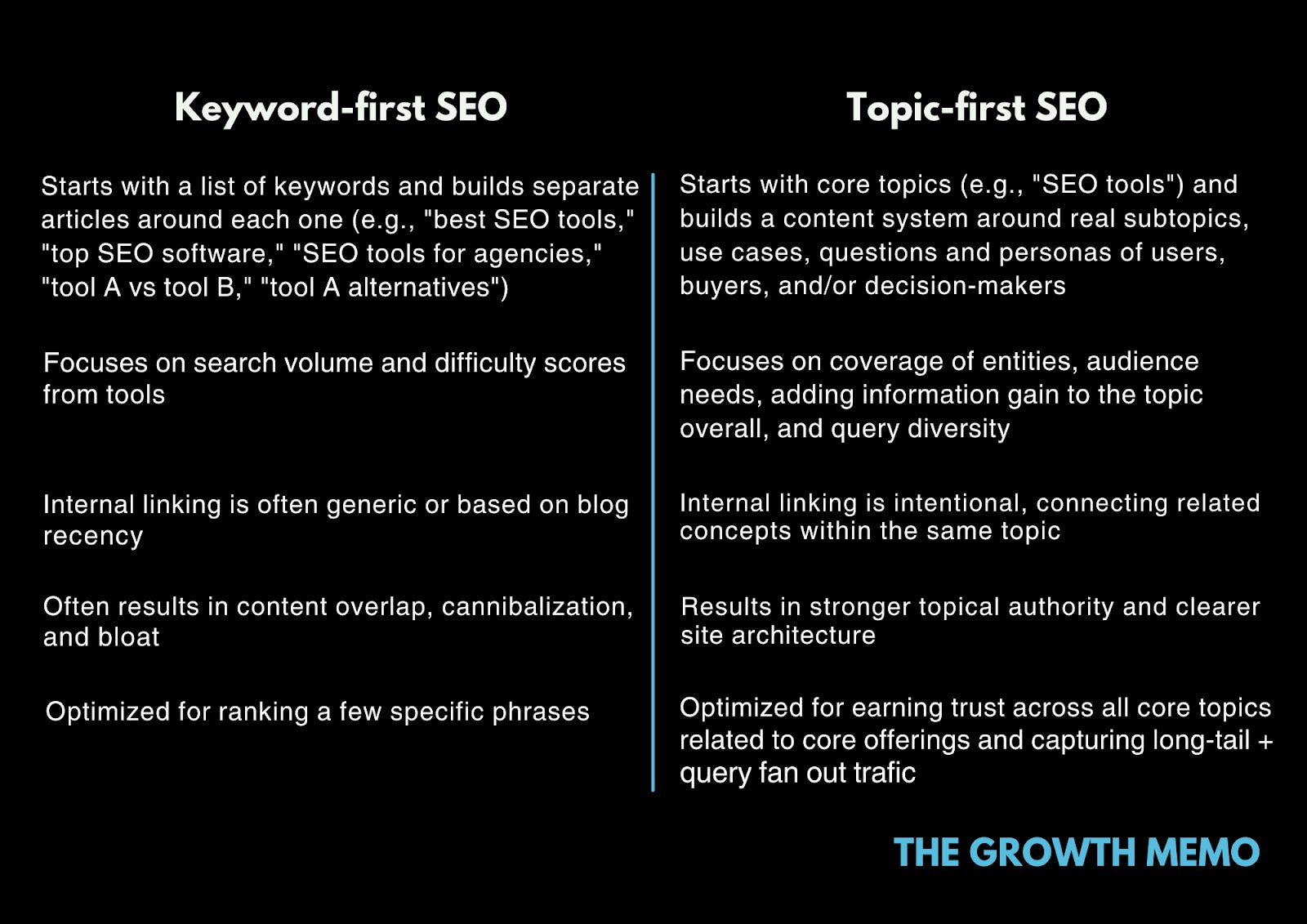
Old Way: Keyword-First SEO
The classic approach to SEO centered around picking individual keywords, assigning each one a page, and publishing content that aimed to rank for that phrase.
This model worked well when Google’s ranking signals were more literal (think string matching, backlink anchor text, and on-page optimization carrying most of the weight).
But in 2025 and beyond, this approach is showing its age.
Keyword-first SEO often looks like this:
- Minimal internal cohesion across pages; articles aren’t working together to build topic depth or reinforce semantic signals.
- Content decisions are often driven by average monthly search and tool-based keyword difficulty scores, rather than intent or persona-specific needs.
- A high-effort, low-durability content-first SEO strategy; posts may rank initially and hold for a while, but they rarely stick or scale.
- Monitoring performance is often focused on traffic projections and done by page type, SEO-tool-informed intent type, query rankings, and (yes) even sometimes topic groups.
But even when teams adopt a topic cluster-first model (like grouping related keywords into topic clusters or deploying a topic-focused pillar + cluster strategy), they often stay tethered to outdated keyword logic.
The result? Surface-level coverage for single keywords, frequent content cannibalization, and a site structure that might seem organized but still lacks strategic topic optimization.
Without persona insights, or a clear content hierarchy built around core topics, you’re building with bricks, but no real authority blueprint.
Wait a second. Is optimizing for topics any different from the classic pillar + topic cluster approach?
Yes and no.
A pillar + cluster model (a.k.a. hub and spoke) is a framework that can organize a topical approach.
But strategists should shift from matching pages to exact keywords → covering concepts deeply instead.
This classic framework can support topic optimization, but only if it’s implemented with a topic-first mindset.
Here are the primary differences:
- Keyword-driven pillar + cluster model: Pillar = covers seed keyword target(s); clusters = cover long-tail variations of seed keywords.
- Topic-driven pillar + cluster model:Pillar = offers a comprehensive guide to the topic; clusters = provide in-depth support for key concepts, different personas, related problems, and unique angles.
Simply selecting high-volume keywords to optimize for in your pillar + cluster strategy plan doesn’t work like it used to.
So, a pillar + cluster plan can help you organize your approach, but you’ll need to cover your core topics with depth and from a variety of perspectives, and for each persona in your target audience.
New Way: Topic-First SEO
Your future-proof SEO strategy doesn’t start with a focus on keywords; it starts with focusing on your target people, their problems, and the topics they care about.
Topic-first SEO approaches content through the lens of the real-world solutions your brand provides through your products and services.
You build authority by exploring a topic (one that you can directly speak to with authority) from all relevant angles: different personas, intent types, pain points, industry sectors, and contexts of use.
But keep in mind: Topic-first SEO is not exactly a page volume game, although the breadth and depth of your topic coverage are crucial.
Topic-first SEO involves:
- Covering your core, targeted topics across personas.
- Investing in “zero-volume” content based on actual questions and needs your target audience has.
- Producing content within your topic that offers different perspectives and hot takes.
- Building authority with information gain: i.e., new, fresh data that offers unique insights within your core targeted topics.
And guess what? This approach aligns with how Google now understands and ranks content:
- Entities > keywords: Google doesn’t just match “search strings” anymore. It understands concepts and audiences (and how they’re related) through the knowledge graph.
- Content built around people, problems, and questions: You’re not answering one query when you optimize for a topic as a whole; you’re solving layered, real-world challenges for your audience.
- Content journeys, not isolated posts: Topic-first strategies map content to different user types and their stage in the journey (from learning to buying to advocating).
- More durable visibility + stronger links: When your site deeply reflects a topic and tackles it from all angles, it attracts both organic queries and natural backlinks from people referencing real insight and utility.
- That E-E-A-T we’re all supposed to focus on: Kevin discusses this a bit more when he digs into Google Quality Rater Guidelines in building and measuring brand authority. But this is an absolute no-brainer: Taking a topic-first approach actively works toward establishing Experience, Expertise, Authoritativeness, and Trustworthiness.
I wanted to know how others are doing this, so over on LinkedIn, I asked for your thoughts and questions.
Here are some that stuck out to me that I think we can all benefit from considering:
Lily Grozeva asks: “Is covering a topic and establishing a brand as an authority on it still a volume game?”
My answer: No. I think Backlinko is a good example. The site built incredible visibility with just a few, but very deep guides.
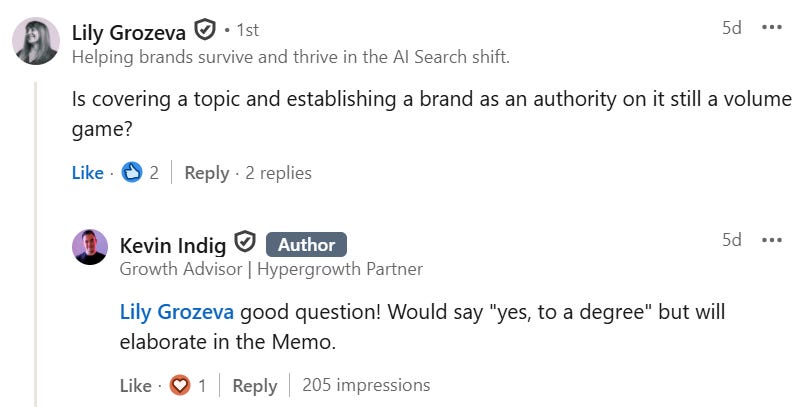 Image Credit: Kevin Indig
Image Credit: Kevin IndigDiego Gallo asks: “Any tips on how to decide if a question should belong to a page or be its own page?”
My answer: “In my experience, one way to determine that is cosine similarity between the (tokenized, embedded) question and the main topics / intents of the pages that you can pick from.”
Diego also left a good tip for covering all relevant intents: Build an “intent template” for each page (e.g., product landing page, blog article, etc.). Base the template on what works well on Google.
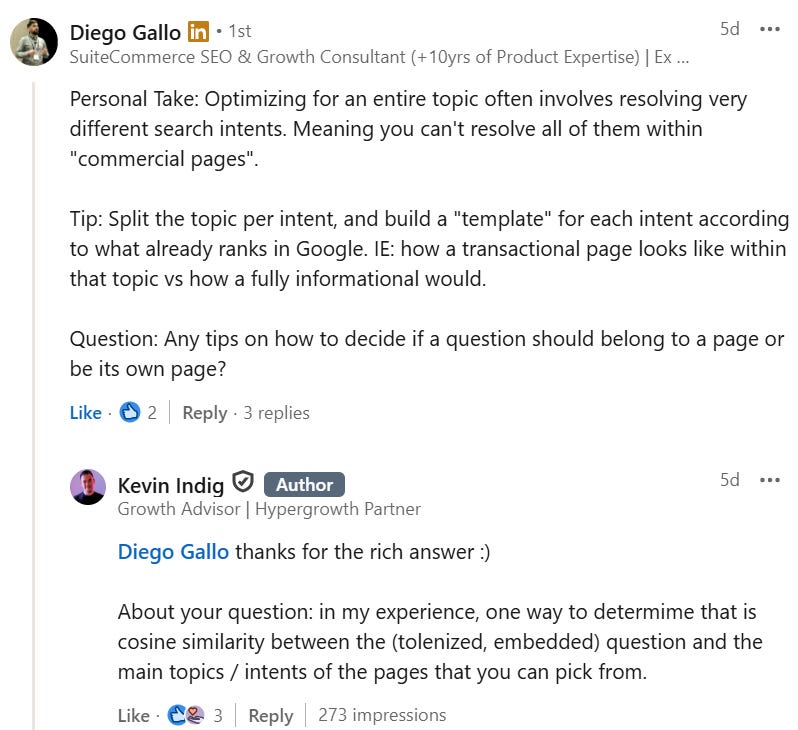 Image Credit: Kevin Indig
Image Credit: Kevin IndigMatthew Mellinger called out that you can use Google’s People Also Asked questions to get clarity on which questions to answer on a page.
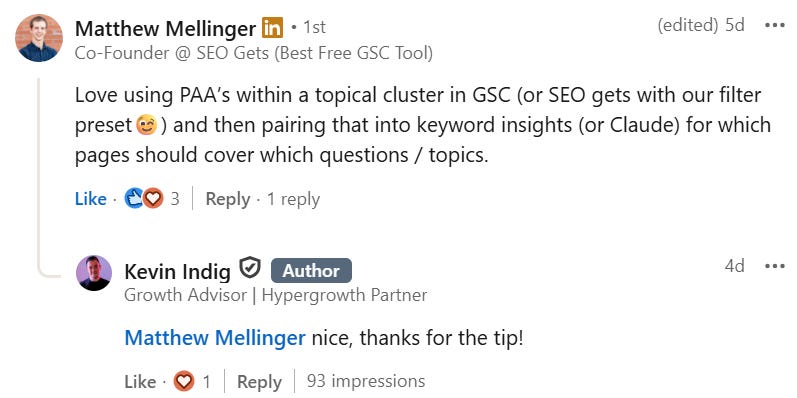 Image Credit: Kevin Indig
Image Credit: Kevin IndigBy the way, you can also use the intent classifier I built for premium subscribers for this task!
Gianluca Fiorelli put a cool analogy on the table:
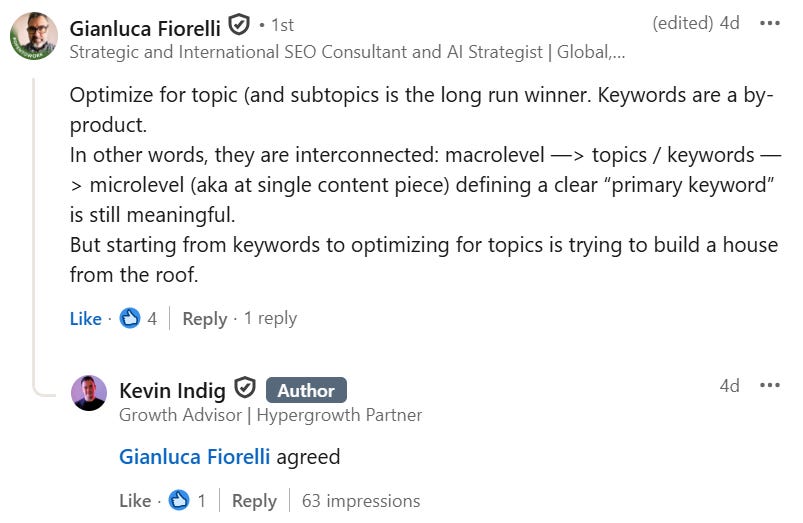 Image Credit: Kevin Indig
Image Credit: Kevin IndigNot Strategizing With A Topic-First Mindset? You’re Outdated
Next week, we’re going to take a deep look at operationalizing a topic-first SEO strategy, but here are some final thoughts.
While there are so many unknowns in the current search landscape, there are a few truths we can ground ourselves in, whether optimizing for search engines or LLMs:
1. Your brand can still own a topic in the AI era.
As shown in the data via the UX study of AIOs, brand/authority is now the first gate users walk through when considering a click off the SERP, search intent relevance the second; snippet wording only matters once trust is secured.
If people are going to click, they’re going to click on the familiar and authoritative. Be the topical authority in your areas of expertise and offerings.
Have your brand show up again, and again, and again in search results across the topic. It’s simple, but it’s hard work.
2. I don’t think focusing on a topic-first mindset could backfire in any way (in 2025 or beyond).
Demonstrating to your core ICPs – whether they find you via paid ads, organic search, LLM chats, socials, or word-of-mouth – through authoritative, branded website content that you understand the topics they care about, questions they have, and provide the solutions for their needs specifically only builds trust … no matter how your brand is found.
3. Build topic systems, not just articles or pages.
Integrators need to take a page out of the aggregator’s product-led SEO playbook: Create a comprehensive system (similar to TripAdvisor’s millions of programmatic pages supported by user-generated content (UGC) reviews, but you don’t need millions 😅) built around your topics of expertise that tackle perspectives, solutions, and questions around each persona type for each sector you serve.
Build the organizational structure within your site that makes these topics and personas easy to navigate for users (and easy to crawl and understand for bots/agents).
4. Persona or ICP-based content is more useful, less generic, and built for the next era of personalized search results.
‘Nuff said. If you strategize topic optimization through the lens of personas (even to the point of including real interviews, surveys, comments, and tips from these persona types), you’re adding to the conversation with depth and unique data.
If you’re not building audience-first content, does optimizing for LLMs and search bots even matter? You’ll gain visibility, but will you gain trust once you finally earn that click?
Featured Image: Paulo Bobita/Search Engine Journal
